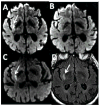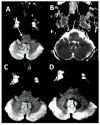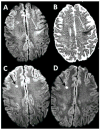Negative diffusion-weighted imaging after intravenous tissue-type plasminogen activator is rare and unlikely to indicate averted infarction
- PMID: 23572476
- PMCID: PMC3690771
- DOI: 10.1161/STROKEAHA.111.000486
Negative diffusion-weighted imaging after intravenous tissue-type plasminogen activator is rare and unlikely to indicate averted infarction
Abstract
Background and purpose: Some patients treated with intravenous (IV) tissue-type plasminogen activator (tPA) have negative diffusion-weighted imaging (DWI) on follow-up imaging. Without a visible infarct, there may be uncertainty as to whether the patient was having a stroke that was averted by tPA or whether the symptoms had not been cerebrovascular in origin. We evaluated patients presenting with suspected acute stroke with a positive DWI lesion before IV tPA to determine the probability of finding a negative DWI up to 48 hours after treatment.
Methods: We included patients from the Lesion Evolution in Stroke and Ischemia On Neuroimaging (LESION) project who had acute MRI screening with a positive DWI lesion before IV tPA treatment and had follow-up MRI up to 48 hours later. Experienced readers interpreted all acute and follow-up MRIs looking for ischemic lesions on DWI.
Results: There were 231 patients who met study inclusion criteria, of which 225 patients (97.4%) had a persistent positive DWI corresponding to the acute stroke lesion on all follow-up imaging. Four patients (1.7%) had transient DWI lesion reversal with positive DWI on subsequent follow-up imaging. There were only 2 cases (0.9%) of complete DWI lesion reversal on all follow-up imaging.
Conclusions: Averted infarction after IV tPA is rare, occurring in 0.9% of patients with pretreatment positive DWI evidence of acute ischemia. For IV tPA-treated patients who have a negative DWI on follow-up imaging, a cause other than acute stroke should be explored.
Keywords: MRI; acute stroke; diffusion-weighted imaging; tPA; thrombolytic therapy.
Figures



References
-
- Uchino K, Massaro L, Hammer MD. Transient Ischemic Attack after Tissue Plasminogen Activator: Aborted Stroke or Unnecessary Stroke Therapy? Cerebrovascular Diseases. 2010;29:57–61. - PubMed
-
- Tsivgoulis G, Alexandrov AV, Chang J, Sharma VK, Hoover SL, Lao AY, et al. Safety and Outcomes of Intravenous Thrombolysis in Stroke Mimics. Stroke. 2011;42:1771–4. - PubMed
-
- Chang J, Teleb M, Yang JP, Alderazi YJ, Chapple K, Frey JL, et al. A Model to Prevent Fibrinolysis in Patients with Stroke Mimics. Journal of stroke and cerebrovascular diseases : the official journal of National Stroke Association. 2011 - PubMed
-
- Giraldo EA, Khalid A, Zand R. Safety of Intravenous Thrombolysis within 4.5 h of symptom onset in patients with negative post-treatment stroke imaging for cerebral infarction. Neurocrit Care. 2011;15:76–9. - PubMed
Publication types
MeSH terms
Substances
Grants and funding
LinkOut - more resources
Full Text Sources
Other Literature Sources
Medical
Miscellaneous

